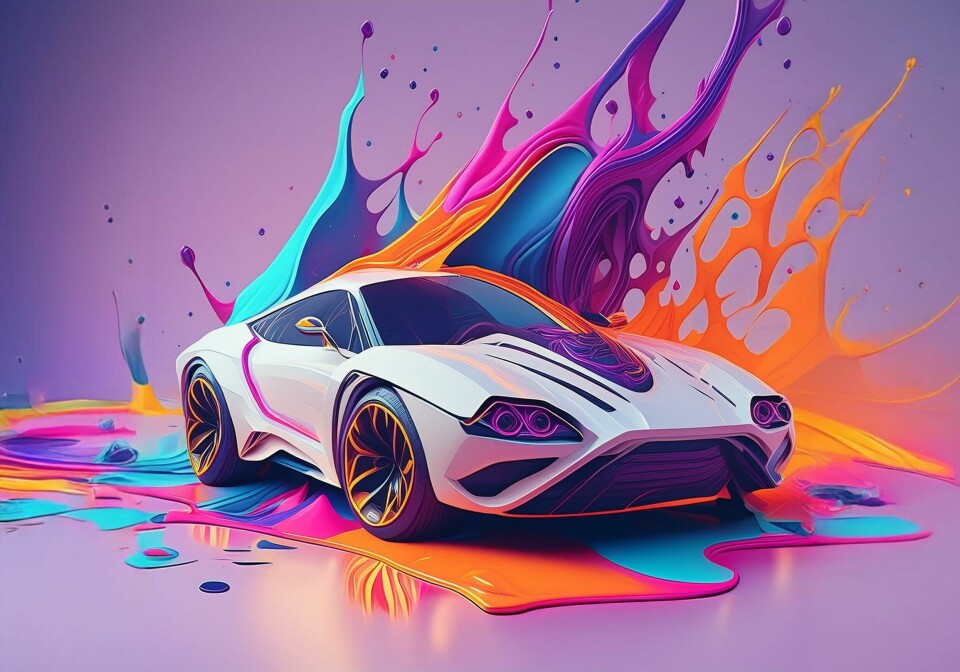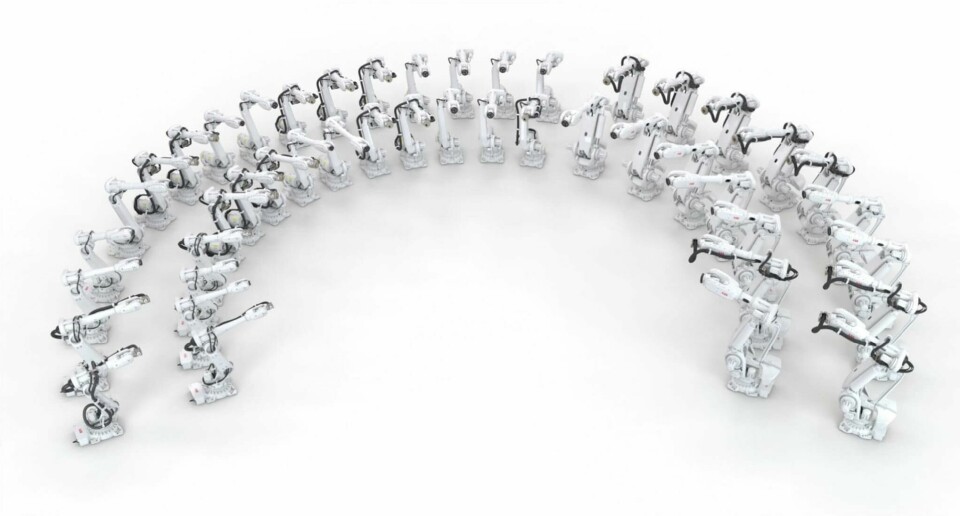
Is ABB Robotics’ new inkjet paint tech the future of automotive paintshop?
Automotive production paintshop is energy-intensive and costly. Could a new ‘inkjet’-type paintshop technology solve several production issues at once? With major implications for sustainability and customisation, ABB’s PixelPaint sees an explosion in demand.
In a somewhat counterintuitive, but key statistic, paint and coatings account for around 30% of a vehicle’s total production costs, including facilities and energy, according to materials science publication, Azo materials. This is consequential. With paintshop operations and technologies being such major contributors towards net energy output and sustainability footprints in vehicle production, the segment seems to be one of the most critically overlooked areas in automotive manufacturing carbon cutting efforts. But efforts are being made.
In March of this year for example, Audi’s manufacturing facility in Brussels launched an initiative aimed at reducing its freshwater usage, with a focus on paintshop operations, by up to 100,000m3 per year annually. The project involves a continuous closed-loop cycle in which water is treated off-site and then reused, and is just one of the ways in which paintshop is seeing innovations towards cutting costs and energy.
But there is another consideration which underlines the importance of automotive paintshop. In terms of trends driving automation, one of the most notable is the demand for individualised consumer products. Consumers are increasingly seeking unique, customised items, which is a trend evident in automotive, with the ability to personalise the design and paint of a vehicle, presenting a significant production case for customised vehicle paint.
Another overlap is that paintshop is, of course, bound up with automation and robotics. So to find out more about the latest developments in automotive paintshop, I visited the ABB robotics centre in Friedberg, Germany; one of ‘the big four’ players across automotive automation.
Automation and Paintshop at ABB Robotics Friedberg: a case study in converging technologies
ABB Freidberg is a small town of robot occupants of every description, with 46 variants under ABB’s wing for every macro mechanical task, and capable of lifting loads ranging from 70kg to 620kg.

The facility is comprised of a Robotics Training Centre where clients are taught how to program and operate their robots, a Technology Centre showcasing many of the robots at work, and the Paint Technology Center, a fully-equipped demo, testing, and validation cell for car-body painting, housing the main event: ABB’s new PixelPaint cell.
”This technology operates like an inkjet printer, and its speed depends on the size of the printing head”
Productivity and quality have always been paramount in robotics, focusing on enhancing efficiency and maintaining high standards. However, to penetrate new markets, simplicity and flexibility are becoming the primary drivers for the future.
Eliminating ovens and industrial-level ventilation from the paintshop process
One unique evaluation that ABB has received pertains to its comprehensive paint booth, predominantly used in the automotive sector. ABB has, of course, the capability to paint an entire car body using traditional methods, featuring atomisers, ventilation, and an oven. The new technology though, PixelPaint, is an innovative approach which caters to two-tone applications and car paint customisation without the need for ovens, extensive ventilation and all the space-consuming production hardware related to traditional paintshop.

Joerg Rommelfanger, Head of Robotics Division Germany & Head of Local Business Line Automotive, says, “there is indeed a difference, both in terms of application tech and time. This technology operates like an inkjet printer, and its speed depends on the size of the printing head.” Currently, ABB has not achieved the same speed as traditional atomiser printing methods, but they are making significant progress, and fast. “At present, we are operating at approximately 200mm per second, which is adequate for specific tasks such as painting a black roof or hood. This speed helps save time by eliminating the need to mask the car and reintroduce it into the paintshop.”
“Our system has a complete ecosystem, including the printing unit, paint distribution, and robot controller, which is crucial for customers in terms of operation and programming”
However, the robotics giant is continually working to increase the printing speed. “We anticipate a transitional period where both technologies—printing and high-efficiency atomizers—will be used in combination,” says Rommelfanger. “And this hybrid approach will gradually evolve towards a fully-automated printing process for the entire car body.”
The design of current paint-lines reflects this hybrid approach, incorporating both atomiser cells and overspray-free painting cells. OEMs are also adopting this design for their own paintshops, indicating a trend towards integrating both technologies as the tech advances.

Juergen Kristen, Manager Technology, Business Line Automotive, ABB, adds, “we’ve been working on this technology for roughly five or six years. This year, we’ve moved beyond the development phase, as we now have our fifth order for production cars from customers.”
The idea behind PixelPaint was initially to address the challenges associated with two-tone painting. Traditionally, customers had to mask the car, run it through the paintshop a second time, and then demask it, which is both costly and environmentally unfriendly.
“But this paint tech eliminates these issues by functioning like an inkjet printer designed for paint,” says Kristen, “which is thicker than water-based ink. It can start printing directly at the edge, providing precise results.” The technology has several advantages, many of which, with the right development, could potentially become a mainstay across automotive production paintshops. Besides painting surfaces, the ‘ink-jet approach’ can print detailed images, as demonstrated in customer trials. The resolution ABB achieves through its own PixelPaint tech, is 360 dpi - quite high for automotive painting.
Not yet perfect tech: priming the surface for development
Kristen admits that some environmental factors may introduce minor imperfections, but still maintains that the quality remains impressive.
“Of course, there are occasional setbacks,” he says, “such as issues with paint materials or equipment challenges. However, overall, the experience has been very positive. Sometimes, we see small imperfections, which might be due to a nozzle not being properly cleaned. Normally, we perform a flash priming of the system and some test prints before starting the main printing process. This ensures quality results.”
Joerg Reger, the Managing Director of ABB Robotics, Automotive Business Line,” says Rommelfanger, “I learned that our initial focus was on local painting, such as adding race stripes on flat surfaces like the bonnet or roof. We then aimed to cover 80% of the car body with PixelPaint.
“Ultimately, our objective is to paint an entire car body, including complex areas like A-pillars and B-pillars, with 100% transfer efficiency”
One of the major advantages of the system is its versatility. It can print both horizontally and vertically without the material sagging, “unlike some of our competitors who face issues with their inkjet printing technology,” says Kristen. “Our system has a complete ecosystem, including the printing unit, paint distribution, and robot controller, which is crucial for customers in terms of operation and programming.
“For example, we can print a picture within roughly 10-15 minutes.” This speed is a significant advantage. ABB’s system doesn’t rely on a conventional nozzle to distribute paint droplets. Instead, it uses a piezoelectric mechanism with over 1500 nozzles to achieve higher-resolution printing.
Standing in the paint tech centre, I peered through a large glass screen into the new paint cell as the ABB team gave me a demonstration of what this tech could do. An image was fed into the computer system, connected to the robotics arm equipped with the new head for paint application; and to my surprise, quickly painted a monochromatic book-sized ABB logo onto a metal plate - that could have just as easily been the hood of a car. That which intially seems like a gimmick actually holds a lot of potential for paintshop in vehicle production.
‘Inkjet’ automotive spray tech in action
“There’s another major difference with this technology,” says Kristen. “The jump in resolution is remarkable. The base coat, being a very fine material, ensures that pixels stay precisely on the substrate. When coupled with a clear coat, it provides sun and scratch protection. Customers looking to save on clear coating can use a single-coat approach, though for decorative purposes, some may choose a higher-quality paint may.”
Is Inkjet-paintshop technology set to take off in automotive production?
“With our paint lab fully-booked for the entire year for conducting tests and validations with customers,” says Rommelfanger, “the demand for this technology has been extraordinary.
“We have already implemented the first installations in the market with several leading OEMs. The demand is proving to be unprecedented, and of course, we are continuously developing it further.”
And there are obvious reasons as to why. By eliminating the conventional need for masking and demasking processes, PixelPaint can significantly reduce both the time, costs and energy expenditure associated with automotive paintshop.
In terms of manpower, traditionally, achieving a two-tone finish involved meticulous masking between paint applications, requiring a large labour force and considerable time investment - up to 20 operators per shift, with additional personnel needed for demasking after applying the second coat. Through enhancing this process by eliminating the manual masking and demasking steps, this new approach is able to improve operational efficiency and reduce material wastage.
“The enhancement can boost productivity by up to 100%”
It also ensures precise application of paint without overspray, as every bit of paint is directed onto the vehicle surface with more precision, allowing for a complete redesign of the paint job process, while also reducing ventilation needs, and contributing to sustainability by minimising paint wastage..
From a productivity standpoint, PixelPaint enables both colours of a two-tone finish to be applied in a single paint run. “The enhancement can boost productivity by up to 100%,” says Rommelfanger, “eliminating the need for multiple paintshop runs and the associated utility expenses, such as power, water and compressed air consumption.”

Interestingly, due to the significant cost savings, energy savings and personalisation capabilities of the technology, I’m informed that vehicle manufacturers are even willing to make slight design adjustments to facilitate this new painting method. Given the complexity of printing on edges, these discussions are crucial. The dynamic dialogue with manufacturers is driving a significant market interest in pixel paint.
“In a recent conversation with Joerg Reger, the Managing Director of ABB Robotics, Automotive Business Line,” says Rommelfanger, “I learned that our initial focus was on local painting, such as adding race stripes on flat surfaces like the bonnet or roof. We then aimed to cover 80% of the car body with pixel paint.
“Ultimately, our objective is to paint an entire car body,” says Reger, “including complex areas like A-pillars and B-pillars, with 100% transfer efficiency using pixel paint.”



